Tomato (Solanum lycopersicum) is America's most popular home garden vegetable. Tomatoes require a relatively small area, bear repeatedly, are widely adapted and easy to grow, and have many culinary uses. Tomatoes are rich in vitamins A and C, low in calories, and an excellent source of lycopene. The latter is the pigment that makes tomatoes red and has been linked to the prevention of many forms of cancer.
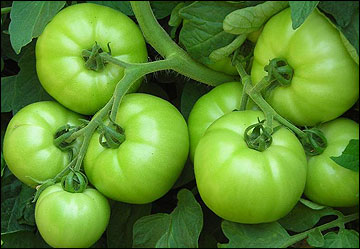
Varieties
Home gardeners have access to many excellent tomato varieties, ranging from new hybrids to tasty heirlooms. When selecting varieties, consider their productivity, disease resistance and potential for fruit splitting. Fusarium wilt and verticillium wilt are two common problems that can be overcome by selecting wilt-resistant varieties and rotating the planting so that these organisms are not able to build up in the soil. Leaf diseases such as early blight cause substantial leaf damage in many home gardens. Although high-quality fruit varieties with resistance to this disease are not generally available, they exist and may soon become more common.
The hybrid tomato varieties listed here have been selected for quality fruit and good disease tolerance or resistance and have performed well under Missouri conditions.
Better Boy (VFN)
An old standby with vigorous, productive plants, Better Boy has maintained its popularity for many years. Fruits are firm and globe-shaped and average between 8 and 16 ounces. Quality is good, and production is abundant. Matures in about 75 days.
Big Beef Plus (VFN)
An improved version of the very popular Big Beef, this variety has better flavor, adaptability, disease resistance and appearance. Like the original Big Beef, it is an All-America Selections award winner. Fruits are smooth with intensely red interiors, may weigh 10 to 12 ounces, and are produced abundantly. Matures in about 73 days.
Celebrity (VFNT)
This variety was an All-America Selections winner in 1984 and continues to be popular. Plants are determinate, which indicates that vines are short and bushy, not lending themselves to staking. Fruits are firm and red and weigh 7 to 8 ounces. Plants are highly productive, and first harvest can be expected in about 70 days.
Early Girl (VF)
True to its name, Early Girl matures in only 52 days, making it one of the earliest varieties available. It bears medium-sized fruit of 4 to 6 ounces in abundance on indeterminate plants and probably is best suited as a companion variety to provide early tomatoes from the home garden.
Jet Star (VF)
This variety has maintained popularity and continues to be a favorite of home gardeners. Fruits are abundantly produced and weigh about 8 ounces. Fruits are crack-resistant, meaty and flavorful. Considered relatively low in acidity.
Lemon Boy (VFN)
For gardeners interested in yellow tomatoes, Lemon Boy is a newer variety that is productive and attractive. Fruits are not a golden color like varieties such as Carolina Gold but are lighter yellow. Fruits are firm and weigh about 6 to 7 ounces. Plants are vigorous and productive and mature in about 72 days.
Red Deuce (VFT)
This hybrid, determinate tomato matures in about 75 days. The globe-shaped fruit has a concentrated set with good size, flavor and external appearance. Performs well in cages or short-stake trellising. Very popular among commercial growers.
Supersweet 100 (VF)
This vigorous, indeterminate variety yields hundreds of small cherry tomatoes with incredible flavor. Bite-sized fruit are borne in grapelike clusters and are widely known for their sweetness. Plants mature in about 65 days.
Producing tomato plants
Earliness of production and quantity of fruit produced may be influenced by quality of the plant at the time it is set in the garden.
The ideal tomato plant should be 8 to 10 inches tall and dark green with a stocky stem and a well-developed, healthy root system. Producing a transplant of this size usually takes four to six weeks, depending on environmental conditions.
A family interested in having only fresh fruit should plant three to five plants per person. If enough fruit is wanted for processing, then five to 10 plants per person should be planted.
To get best results with only a few plants and minimal trouble, purchase plants from a local greenhouse or nursery at the proper planting time.
If a fairly large number of plants is needed, the plants may be started from seeds in a good, porous seeding mix. When seedlings are large enough to handle, transplant them into individual containers or bedding plant packs for stocky development. Give them plenty of light.
If kept in the house, expose the plants to a south window, and rotate them regularly to produce uniform growth. Daily temperatures should be kept below 80 degrees F but not lower than 50 degrees F.
Additional information on producing tomato transplants can be found in MU Extension publication G6570, Starting Plants Indoors From Seeds.
Selecting growing area
Tomatoes grow best when they receive full sunshine. Plant them away from trees and buildings to get highest yield. A tomato plant needs a lot of water, so arrange for easy watering. Select a well-drained area because poor soil aeration leads to root loss and physiological problems such as blossom end rot.
Preparing soil for planting
Tomato plants grow well in many types of soil. Work the soil only when it is dry enough so it will not stick to tools. Improve garden soil by adding organic matter such as peat moss, leaf mold, well-rotted manure or compost. Tomatoes grow best in nearly neutral soil with pH of 6.5 to 7.0. If soil test results indicate the need for lime, add it in late fall or early spring.
Fertilizing
Add a complete garden fertilizer at the time the soil is prepared. For tomatoes, use a fertilizer low in nitrogen (N), high in phosphorous (P) and medium to high in potassium (K). Among the best analyses for tomatoes are 8-32-16 and 6-24-24. Avoid using ammonia fertilizers such as urea or ammonium nitrate for tomato fertilization.
Use a maintenance rate of 1 pound per 100 square feet after the proper fertility level has been developed from previous soil tests and fertilizations. If only 5-10-5, 5-10-10 or similar analyses are available, apply 2 pounds per 100 square feet.
All fertilizer should be worked well into the top 6 inches of soil. Additional information on soil preparation and fertilization can be found in MU Extension publication G6950, Steps in Fertilizing Garden Soil: Vegetables and Annual Flowers.
Setting out plants
Set tomatoes in the garden when the weather has warmed and soil temperatures are above 60 degrees F. Temperatures below 50 degrees F impair tomato growth.
In southern Missouri, plant tomatoes outside from April 20 to May 15. In central Missouri, May 5 to 20 is the approximate planting time, and in northern Missouri and the Ozark area, planting from May 10 to 20 is usually best. In all areas, plants may be set out several days to a week earlier if gardeners are willing to protect them from a possible frost.
Before planting tomatoes, remove all clay pots, plastic pots or wood bands from the soil ball. Peat pots may remain. Set plants a little deeper than they were originally growing so lower leaves are near the ground. If only "leggy" plants are available, plant them at about a 30-degree angle in a trench long enough to leave only the top 5 or 6 inches of the plant exposed. Roots will develop along the buried portion of the stem. If the plant is in a peat pot, make sure the entire pot is covered, because exposed portions of the pot will act as a wick and rapidly dry the root ball.
Apply 1 cup of a fertilizer solution around the roots after placing the plant in the hole. Use a completely soluble fertilizer high in phosphorus, such as 9-45-15 or 15-30-15, at the rate of 2 level tablespoons per gallon of water. Guard the plant base from cutworms with a wax paper collar about 3 inches high (2 inches above the ground and 1 inch below).
Planting distances
Proper spacing and staking are essential for healthy plants and good fruit production. Planting distance depends on the type of tomato grown. Ideal spacing for home garden tomatoes is generally 24 to 36 inches between plants. Planting closer than 24 inches reduces air circulation around the plants and can trigger disease outbreaks. Large-vine tomatoes should be spaced 36 inches apart. Rows should be 4 to 5 feet apart.
Staking
Staking improves marketable yield, fruit set and fruit quality and also makes harvesting easier. Staked plants are less likely to get diseases, since their foliage dries more quickly following rain or heavy dew. Stakes can be made from a 6 foot long, 1 x 2-inch piece of wood, pointed at one end. Place it firmly into the ground about 4 inches from the plant at time of transplanting. Use soft biodegradable twine for tying plants to the stake, and allow at least half an inch of slack for stem enlargement.
Many gardeners prefer to support tomato plants in cylindrical wire cages. Mesh should be wide enough for a person's hand to fit through to pick fruits. This method saves time required for staking, pruning and tying.
Pruning
Determinate and semi-determinate varieties typically do not require pruning. However, large-vine (indeterminate) varieties benefit from the removal of some of their axillary or side shoots, "suckers", or from being topped to prevent plants from becoming too bushy and tall.
When plants are grown in cages, less pruning is required. Break out only enough shoots to allow good light and air movement through the cage.
Watering
A tomato fruit is 95 percent water, so tomatoes need lots of water to grow and develop fruit. They should receive 1 to 2 inches of water a week. If this amount is not received as rainfall, then supplemental irrigation is necessary.
Soak the soil thoroughly when watering. Frequent light waterings will encourage a weak root system. Mulching with straw, clean hay, compost, paper or plastic will reduce soil water evaporation. Plants growing in small containers may need daily waterings.
Side-dressing
Fertilizer applied at the time of planting will not supply enough nutrients for the entire season. Too much nitrogen in the beginning results in lush vegetative growth and poor fruit set.
Apply the first side-dressing when the first fruits are about one-third grown. Apply 0.5 pound of actual nitrogen per 100 feet of row. This is equivalent to 5 pounds of 10-10-10 fertilizer. Calcium nitrate is an excellent fertilizer to apply as a side-dress. About 3.5 pounds of calcium nitrate can be side-dressed per 100 feet of row. Mix the fertilizer carefully into the top inch of soil. Don't get fertilizer on the foliage.
Apply the second side-dressing two weeks after picking the first ripe fruit. Make a third application a month later. Water-in the nitrogen if rain is unlikely.
Cultivating and controlling weeds
Many weeds carry diseases that can seriously affect tomato plants when transmitted by insects or humans. Weeds also may harbor harmful insects and compete with tomato plants for soil moisture and nutrients.
Use mulches to avoid a lot of hoeing and hand-weeding. Hay, straw, grass clippings, paper, compost or plastic can be used as mulches for tomatoes. Black plastic warms the soil and is very beneficial for early plantings. Some growers have used red plastic mulch with success. Apply organic materials 2 to 4 inches thick to prevent weeds from developing.
Harvesting
For optimal flavor, tomato fruits should be allowed to ripen fully on the vine but harvested before they begin to soften. Tomato color and flavor are optimal when average daily temperatures are about 75 degrees F. High temperatures – greater than 92 degrees F – during ripening reduce fruit flavor, texture and color. Fruit exposed to high temperatures develops internal white tissue and yellow color on the fruit surface. Thus, it is important to have good vine growth, which partially shades the fruit from intense sunlight. Do not refrigerate tomatoes after harvest. Flavor and quality are preserved by holding the fruit at room temperature.
Mature green fruits can be harvested in the fall and held for later use. Select fruits free of disease, wrap them in paper and store them at about 60 to 65 degrees F. They will ripen slowly and provide good tomatoes for several weeks.
Physiological problems
Many of the following disorders are quite common and should be readily recognized. Little can be done for most of them, but the fruit may be eaten if affected portions are removed. These problems are not caused by insects or disease.
Blossom end rot
Very common problem on homegrown tomatoes. It appears as a depressed brownish, rather dry rot the size of a dime to a half dollar on the blossom end of the fruit. It is caused by a calcium deficiency coupled with wide fluctuations in available moisture. Training and pruning may increase blossom end rot. Remove the affected fruit so other fruits on the plant will develop normally, and keep the plants well-watered and adequately supplied with calcium. Mulch to maintain a more uniform moisture supply. Avoid cultivating, or hoeing, near the roots of tomato plants, which can lead to root pruning and restricted waster uptake. Do not use ammonia fertilizers.
Catfacing
Badly formed tomatoes on the blossom end, usually rough with scar tissue. Cool weather at time of blossom set intensifies the deformities. Catfacing is usually most common in the large-fruited beefsteak-type tomatoes.
Cracking
Fruit cracking varies by the variety. Cracking is usually a problem when soil moisture fluctuates. Tomatoes exposed directly to sunlight are highly susceptible to cracking. Select varieties that are crack-resistant, and keep them adequately watered at all times. Soil drying followed by watering encourages cracking.
Cloudy spots
Irregular whitish spots just under the skin. This is the result of stink bugs feeding on the fruit at some stage in its development.
Flower drop
Especially noticeable on early flowers when the grower is anxious for fruit to set for an early harvest. The problem occurs when night temperatures are lower than 55 degrees F, when day temperatures are higher than 95 degrees F, or when night temperatures remain above 75 degrees F. Hot drying winds may intensify the problem.
Varieties also will differ in their temperature response. Fruit-setting hormones may be used to help set fruit early in the season when the weather is cool. The problem usually disappears and fruits set normally after the weather improves.
Physiological leaf roll
Most common on plants that have been pruned and on early-season varieties. Older and lower leaves of some tomato varieties may roll and become stiff and leathery. It is not a disease and is most common on plants that are trained and pruned. This condition does not appear to adversely affect yield.
Sunscald, poor color
High temperatures retard the development of good color. Fruits exposed to high temperatures will scald and develop uneven color. Good foliage cover helps prevent sunscald.
Chemical problems
Herbicide injury
Drift from 2,4-D, dicamba and similar chemicals commonly used on lawns and in fields may cause distorted leaves, twisted stems, dropping of flowers and fruit abnormalities. The drift may originate half a mile or more away. Sprayers that have been used for herbicide and then used for disease and insect control on tomatoes may also be a source of contamination.
Walnut toxicity
Plants growing near black walnut trees may wilt and die. Avoid growing tomatoes within 50 feet of these trees or where they may come into contact with walnut roots.
Insects
A variety of insects may attack tomatoes, but they can be controlled with a regular spray schedule. The following insects are a few that commonly attack tomatoes.
Aphids
Small, pear-shaped insects that congregate on the top growth or undersides of leaves. Aphids damage tomatoes by sucking plant sap and excreting a sticky substance on the foliage and fruit, making the fruit unattractive. Besides rain, insecticidal soaps and certain chemicals, controls include removing weeds, which may serve as hosts for aphids.
Cutworms
Fat gray, brown or black worms up to 1-1/4 inches long. They cut off plants close to the soil surface. They are most destructive early in the season. Use a wax paper collar as described under "Setting out plants."
Flea beetles
Black or brown jumping bugs 1/16 inch long that attack young transplants and leave them looking as if they have been shot full of small holes.
Hornworms
Large green worms up to 4 inches long that eat foliage and fruit. Handpick the worms if only a few; sprays can be used for large infestations.
Leaf miners
Larvae that make long, slender white tunnels in the leaves. Start sprays early.
Spider mite
Tiny tannish mite, barely visible to the naked eye, that causes many small yellow specks and fine webs. Forceful water sprays, insecticidal soaps or chemical sprays may be used for control.
Stalk borer
Creamy-white to light purple larvae that eat tunnels in the stem, causing the plant to wither and die. Remove and destroy weeds where the insect may breed. Locate hole in stem where the borer entered, split stem lengthwise above the hole, and kill the borer. Bind the split stem, and keep the plant well-watered. Spray to prevent further infestations.
Stink bugs
Brown, green or black shield-shaped bugs that give off a foul odor. They suck juices from the plant and cause hard whitish spots just under the skin of the fruit. Sprays are effective.
Tomato fruitworm
Green, brown or pink worm that eats holes in fruit and buds. Sprays during June help control this insect. Make several applications.
Diseases
Tomatoes are attacked by a number of diseases including bacterial speck and spot, early blight, fusarium wilt, anthracnose, septoria leaf spot, tobacco mosaic virus, curly top virus and verticillium wilt. Information on controlling diseases can be found in MU Extension publication G6202, Disease Prevention in Home Vegetable Gardens.
Audio clips
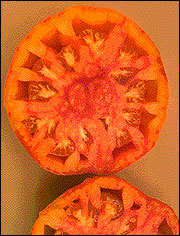
Figure 1
An older tomato variety. The fruit is large and good-flavored, but the seed cavities are large and fairly empty.
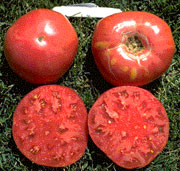
Figure 2
A newer, hybrid tomato. The fruit is meatier and the seed cavities are smaller with fewer seeds.
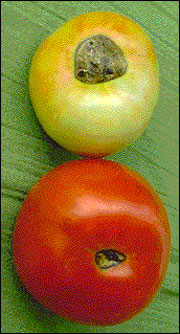
Figure 3
Blossom-end rot is often intensified by high temperatures and low moisture.
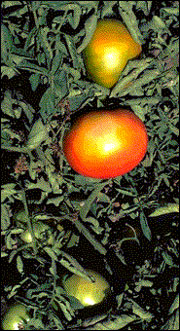
Figure 4
Tomatoes scalded by the sun will turn yellow on the sides or tops.
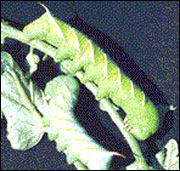
Figure 5
The large green tomato hornworm is a common insect pest of tomatoes.
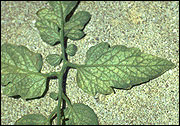
Figure 6
Leaves infested with spider mites will become pale, as shown here.
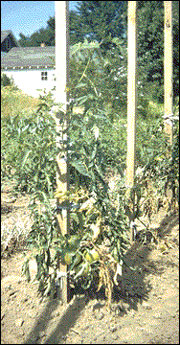
Figure 7
Lower leaves on tomato plants attacked by early blight will spot and turn yellow.